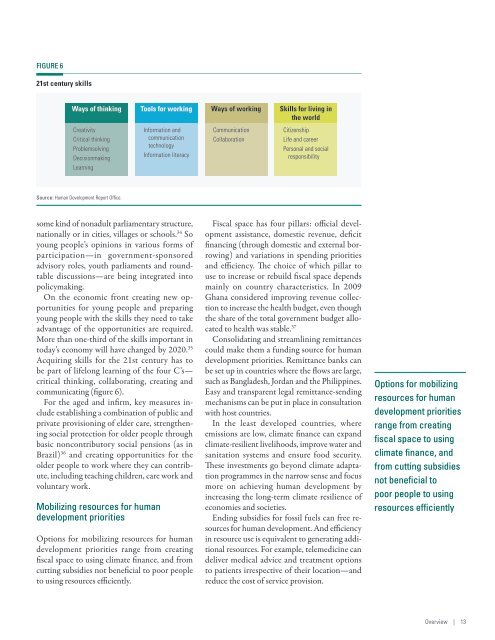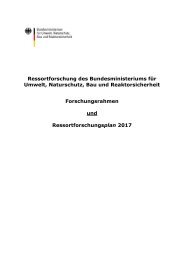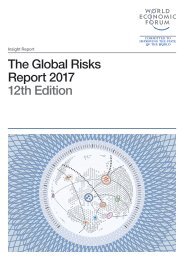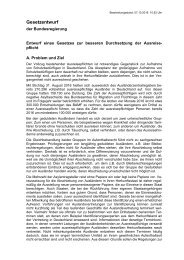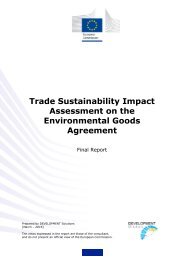Human Development Report 2016
6Tyccfrzw
6Tyccfrzw
You also want an ePaper? Increase the reach of your titles
YUMPU automatically turns print PDFs into web optimized ePapers that Google loves.
FIGURE 6<br />
21st century skills<br />
Ways of thinking<br />
Tools for working<br />
Ways of working<br />
Skills for living in<br />
the world<br />
Creativity<br />
Critical thinking<br />
Problemsolving<br />
Decisionmaking<br />
Learning<br />
Information and<br />
communication<br />
technology<br />
Information literacy<br />
Communication<br />
Collaboration<br />
Citizenship<br />
Life and career<br />
Personal and social<br />
responsibility<br />
Source: <strong>Human</strong> <strong>Development</strong> <strong>Report</strong> Office.<br />
some kind of nonadult parliamentary structure,<br />
nationally or in cities, villages or schools. 34 So<br />
young people’s opinions in various forms of<br />
participation — in government-sponsored<br />
advisory roles, youth parliaments and roundtable<br />
discussions — are being integrated into<br />
policymaking.<br />
On the economic front creating new opportunities<br />
for young people and preparing<br />
young people with the skills they need to take<br />
advantage of the opportunities are required.<br />
More than one-third of the skills important in<br />
today’s economy will have changed by 2020. 35<br />
Acquiring skills for the 21st century has to<br />
be part of lifelong learning of the four C’s —<br />
critical thinking, collaborating, creating and<br />
communicating (figure 6).<br />
For the aged and infirm, key measures include<br />
establishing a combination of public and<br />
private provisioning of elder care, strengthening<br />
social protection for older people through<br />
basic noncontributory social pensions (as in<br />
Brazil) 36 and creating opportunities for the<br />
older people to work where they can contribute,<br />
including teaching children, care work and<br />
voluntary work.<br />
Mobilizing resources for human<br />
development priorities<br />
Options for mobilizing resources for human<br />
development priorities range from creating<br />
fiscal space to using climate finance, and from<br />
cutting subsidies not beneficial to poor people<br />
to using resources efficiently.<br />
Fiscal space has four pillars: official development<br />
assistance, domestic revenue, deficit<br />
financing (through domestic and external borrowing)<br />
and variations in spending priorities<br />
and efficiency. The choice of which pillar to<br />
use to increase or rebuild fiscal space depends<br />
mainly on country characteristics. In 2009<br />
Ghana considered improving revenue collection<br />
to increase the health budget, even though<br />
the share of the total government budget allocated<br />
to health was stable. 37<br />
Consolidating and streamlining remittances<br />
could make them a funding source for human<br />
development priorities. Remittance banks can<br />
be set up in countries where the flows are large,<br />
such as Bangladesh, Jordan and the Philippines.<br />
Easy and transparent legal remittance-sending<br />
mechanisms can be put in place in consultation<br />
with host countries.<br />
In the least developed countries, where<br />
emissions are low, climate finance can expand<br />
climate-resilient livelihoods, improve water and<br />
sanitation systems and ensure food security.<br />
These investments go beyond climate adaptation<br />
programmes in the narrow sense and focus<br />
more on achieving human development by<br />
increasing the long-term climate resilience of<br />
economies and societies.<br />
Ending subsidies for fossil fuels can free resources<br />
for human development. And efficiency<br />
in resource use is equivalent to generating additional<br />
resources. For example, telemedicine can<br />
deliver medical advice and treatment options<br />
to patients irrespective of their location — and<br />
reduce the cost of service provision.<br />
Options for mobilizing<br />
resources for human<br />
development priorities<br />
range from creating<br />
fiscal space to using<br />
climate finance, and<br />
from cutting subsidies<br />
not beneficial to<br />
poor people to using<br />
resources efficiently<br />
Overview | 13


